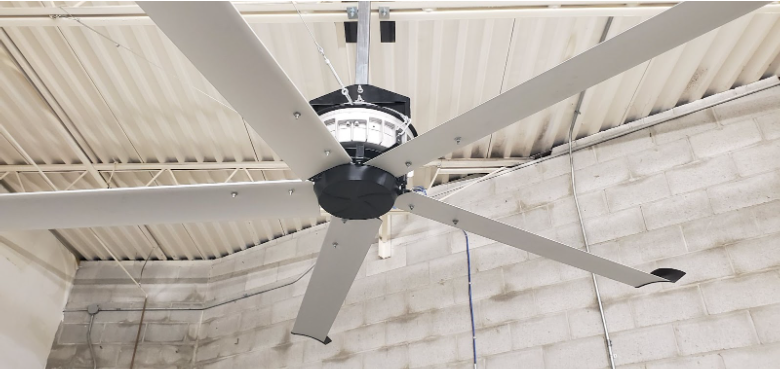
As newer technologies enter the market, industries looking to install fans in their facilities encounter numerous options. To adapt to these changes, warehouse managers look for advanced mechanisms that effectively address modern problems.
Large commercial and industrial spaces require proper airflow, often achieved with ceiling fans or traditional industrial fans. Each option comes with distinct features, advantages, and drawbacks. However, simply knowing their features may not be enough to make an informed choice between the two.
This blog post will discuss the differences between traditional industrial fans and warehouse ceiling fans to help warehouse managers make an informed choice.
Warehouse Ceiling Fans
These fans are commonly chosen to operate in large commercial and industrial spaces. They have longer blades and come in different sizes with diameters covering 7 to 24 feet. As the name suggests, they rotate at a low speed, moving large air volumes and distributing them evenly throughout the warehouse.
Advantages of HVLS Fans
| Energy Efficiency | The low-speed operation of HVLS fans needs less power to transport air volumes than multiple high-speed fans do. |
| Better Air Circulation | The extensive fan blades and relaxed rotation allow them to distribute air consistently across warehouse spaces, thus minimizing temperature inconsistencies. |
| Improved Employee Comfort | Workers experience better comfort through improved airflow because ceiling fans keep the environment less humid, resulting in superior worker comfort. |
| Cost Savings | HVLS fans can be combined with traditional HVAC systems to reduce energy expenses. Thus, businesses do not have to deal with separate heating or cooling systems according to seasonal demands. |
| Quiet Operation | HVLS fans do not create high-pitch noises like traditional fans, creating better work conditions in an industrial setting. |
Possible Drawbacks of HVLS Fans
| Higher Initial Investment | Large warehouse fans require a high initial investment as they need considerable resources for purchase and installation. |
| Installation Complexity | Professional help is needed when installing HVLS fans. This increases the installation costs and times. |
| Limited Directional Control | These fans’ uniform air distribution makes ventilating selected areas challenging as they lack precise airflow control. |
Traditional Industrial Fans
There are different types of traditional industrial fans. Pedestal, wall-mounted and floor fans move rapidly to release a concentrated airflow in targeted areas. They are ideal for industrial applications where fast cooling is required.
Advantages of Traditional Industrial Fans
| Lower Initial Cost | The low initial expenses for traditional industrial fans make them an economical choice for warehouse managers. |
| Moveability and Flexibility | Traditional industrial fans mounted on the wall or connected by plugging into an electrical source can be moved from one place to another according to operational needs. |
| Targeted Airflow | High-speed industrial fans can be used in specific areas with machinery that heats up quickly or workstations to cool down the environment as needed. |
| Easier Installation | Most standard fan units need basic installation since users only need to connect them to an electrical source and find proper placement. |
| Suitable for Smaller Spaces | These fans are most appropriate for warehouses with compact floor space or areas that need targeted cooling. They are more efficient than large ceiling fans. |
Possible Drawbacks of Traditional Industrial Fans
| Higher Energy Consumption | Traditional fans relatively operate at high speeds, consuming more electricity than HVLS fans. |
| Less Effective Air Circulation | The airflow generated by traditional industrial fans is uneven, affecting the adequate distribution of air across large warehouse spaces. |
| Noisier Operation | The high speed of these traditional fans creates heavy noise that can cause disruptions in a work environment. |
| Limited Coverage Area | These fans cover only specific areas; hence, they are inefficient in distributing air throughout a large space. |
What Option Is Suitable For Me?
Selecting between warehouse ceiling fans and traditional industrial fans depends on warehouse size, budget, cooling requirements, and operational objectives.
Choose Warehouse Ceiling Fans If:
- Your warehouse has an extensive area where you need consistent airflow.
- Economic efficiency and sustained cost reduction become your key deciding factors.
- The comfort of employees relies heavily on the ability to reduce noise levels.
- You need HVAC system supplements to improve climate management.
Choose Traditional Industrial Fans If:
- You need targeted cooling in specific areas or for overheated machinery.
- You have budget limitations and require a more affordable solution.
- You want portable fans that can be positioned as per your needs.
- Your warehouse is compact and does not require large industrial fans to regulate air.
Key Takeaways
- Warehouse ceiling fans and traditional industrial fans possess separate benefits and drawbacks for industrial cooling applications.
- Ceiling fans deliver total air circulation at lower operational costs, yet traditional industrial fans maintain affordability, convenient mobility and directed cooling capabilities.
- A warehouse can benefit most from simultaneously deploying fan types to achieve perfect air circulation and comfortable worker conditions.
- Evaluating warehouse requirements and budget will help you discover which fan solution works best for your facility to establish a more efficient workplace with comfortable conditions.
The high-performance fans by Refresh Fans come in different ceiling-mounted, wall-mounted and free-standing styles. Our team members can assist you when choosing a fan to improve air quality and worker comfort and save energy bills in your industrial environment. We follow a personalized approach when working with our clients. This includes assessing your warehouse layout and knowing your budget limitations and organizational requirements. Such factors help us provide the most suitable solution for improving air quality.
Are you still confused about your options? Let us help you! Book an appointment with our team today.